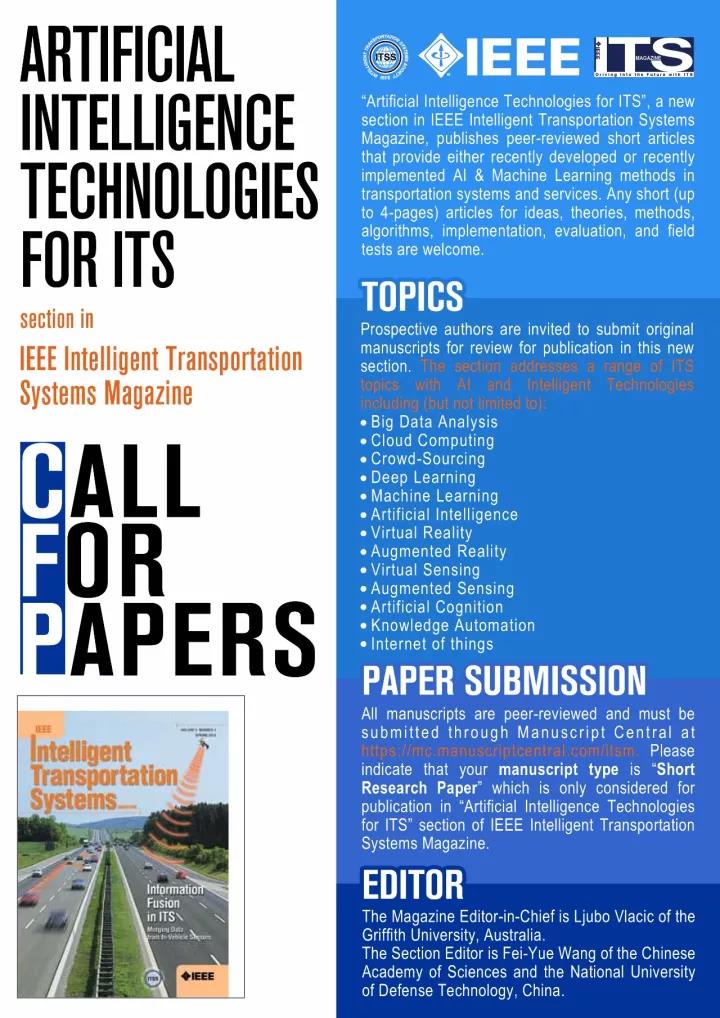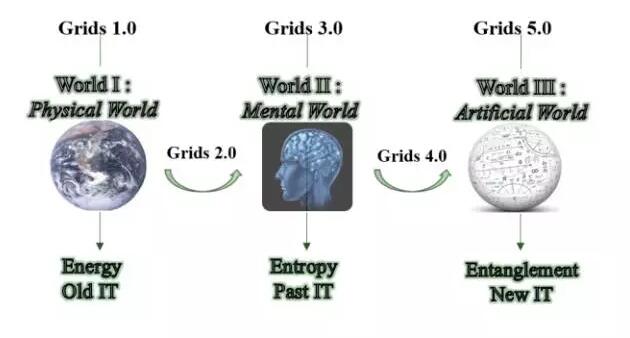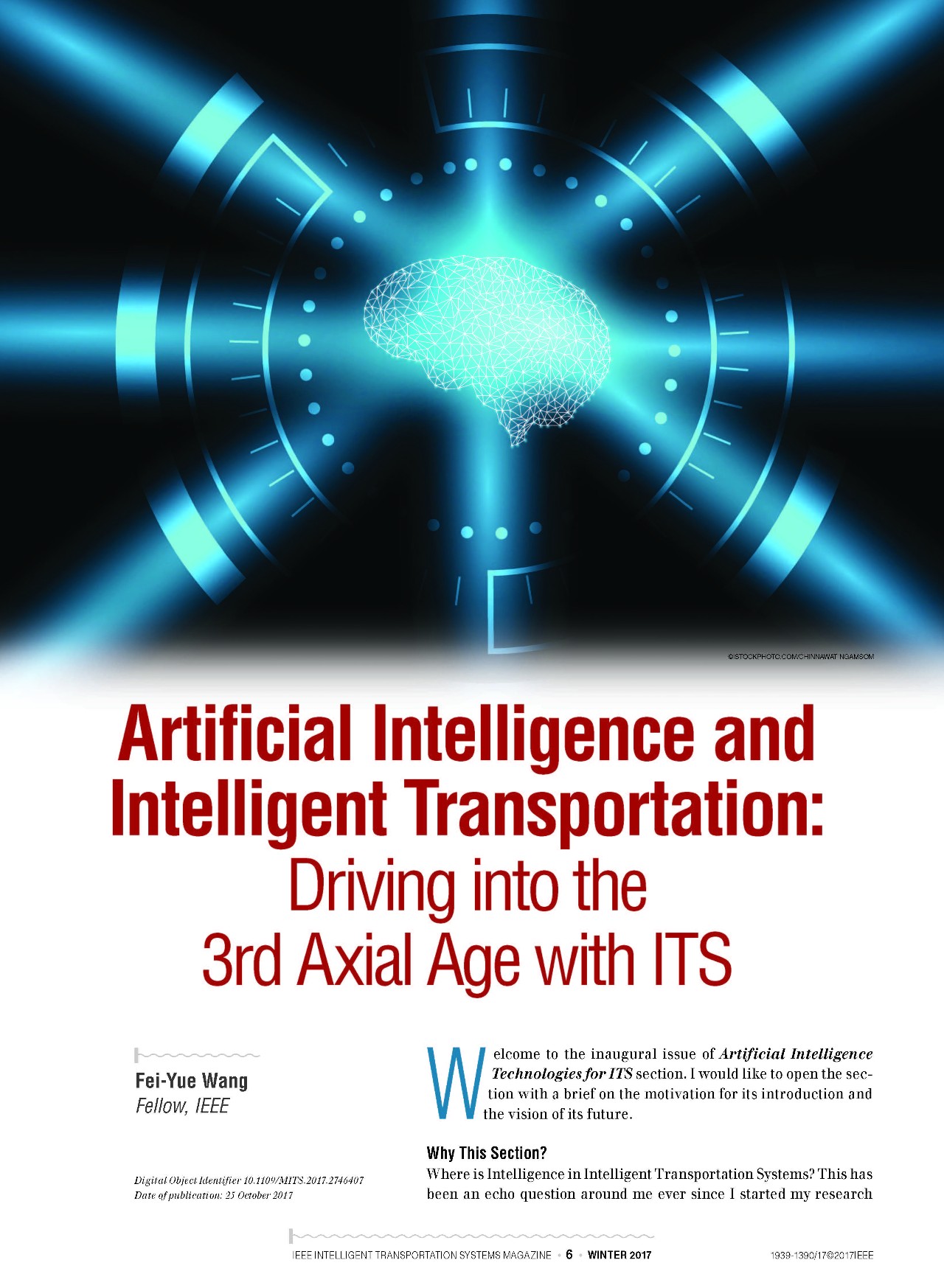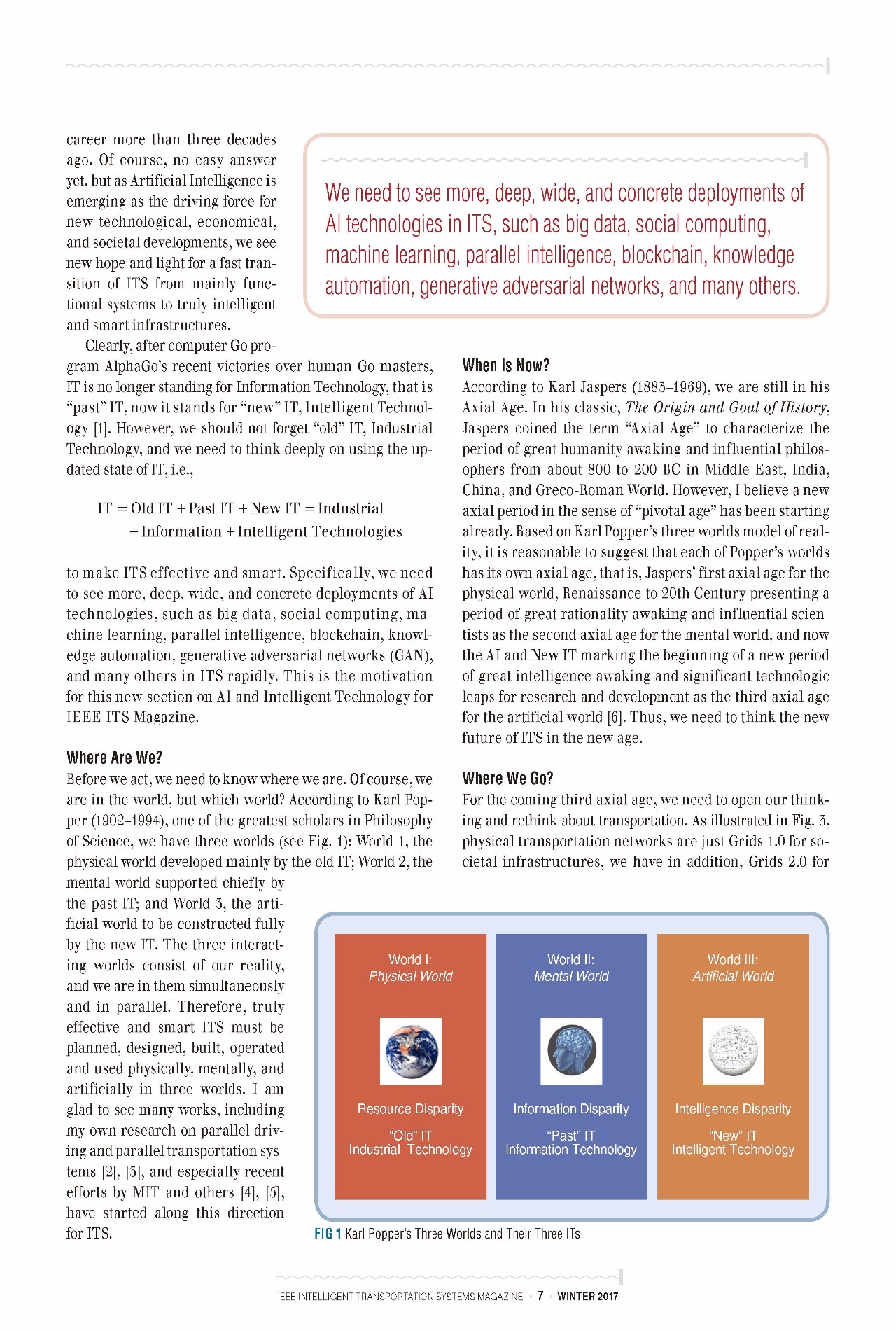博文
ITSM CFP | 王飞跃:智能交通系统驶向第三轴心时代
|

为促进人工智能技术在智能交通系统中的应用,为本领域广大科技人员提供新的交流平台,2017年冬天开始,IEEE智能交通系统杂志开辟了新的专栏:“实现智能交通系统的人工智能技术(Artificial Intelligence Technologies for ITS)”,由复杂系统管理与控制国家重点实验室主任王飞跃教授担任专栏主编。本文是专栏主编的开篇文章,文中详细介绍了开辟这一专栏的动机与未来愿景,并向广大学者发起约稿,希望有更多的学者与科技人员投身这个领域,共同推动人工智能技术在智能交通系统中的应用。
人工智能与智能交通:智能交通系统驶向第三轴心时代
王飞跃
【引文格式】Fei-Yue Wang, Artificial Intelligence and Intelligent Transportation -Driving into the 3rd Axial Age with ITS, IEEE Intelligent Transportation Systems Magazine, Winter 2017, 6-9.
【译 者】陈虹宇,王晓,复杂系统管理与控制国家重点实验室
【文末附征稿通知】Call for Papers: “Artificial Intelligence Technologies for ITS” Section in IEEE Intelligent Transportation Systems Magazine
欢迎阅读“实现智能交通系统(Intelligent Transportation Systems,ITS)的人工智能技术”专栏的开篇文章。此处我通过对自身研究智能交通系统的动机进行简述并对这一研究的未来进行展望来向大家介绍本栏目。
为何开创这一专栏?
智能交通系统中的智能在哪里?自三十多年前我开始自己的研究生涯,这个问题就一直回荡在我的脑海中。毫无疑问,这个问题并不是那么容易回答,但是随着人工智能(Artificial Intelligence, AI)正成为新技术、新经济和新社会发展的驱动力量,我们看到了ITS从主要地功能性系统向真正地智能化和智慧化基础设施快速转变的新希望和曙光。
显然,随着计算机围棋程序AlphaGo近来战胜人类围棋大师之后,IT不再是信息技术(Information Technologies,IT)的代名词,那是“旧”IT,现在它代表“新”IT——智能技术(Intelligent Technologies,IT)[1]。但是,我们也不能忘记“老”IT——工业技术(Industrial Technologies,IT),并且需要对IT最新形式的使用展开深入思考,即
IT = “老” IT + “旧” IT + “新” IT
= 工业 + 信息 + 智能 技术
以使ITS更加高效且智能。具体而言,我们需要快速地了解ITS中更多、深入、广泛和具体的AI技术部署情况,例如大数据、社会计算、机器学习、平行智能、区块链、知识自动化、生成式对抗网络(GAN)以及许多其他技术等。这是IEEE ITS杂志新增这一AI与智能交通系统栏目的内部动机。
我们身在何处?
在我们采取行动之前,需要知道自己身在何处。当然,我们身处世界之中,但又是哪个世界?根据当代最伟大的一位科学哲学家Karl Popper(1902-1994)的观点,我们拥有三个世界(见图1):世界1,主要由“老”IT驱动发展的物理世界(客观世界);世界2,主要由“旧”IT支撑进步的心理世界(主观世界);以及世界3,完全由新IT构建而成的人工世界。三个世界交织构成我们的现实,我们同步且平行地存在于其中。因此,在三个世界的物理、心理和人工层面上,真正高效和智能的ITS必须是可规划、可设计、可构建、可运行和可使用的。我非常高兴看到,许多研究工作,包括我们自己在平行驾驶和平行交通系统方面工作[2][3],特别是MIT和其他科研机构的近期成果[4][5],已经沿着这一方向对ITS展开了相关研究。

图1. Karl Popper的三个世界及其所对应的三个IT
现在是什么时代?
根据Karl Jaspers(1883-1969)的观点,我们仍处在他的轴心时代。在他的著作《历史的起源与目标》中,Jaspers创造了“轴心时代”这一术语,用以描述约在公元前800年到公元前200年间,中东、印度、中国和古希腊罗马那些唤醒人性且极具影响力的伟大哲学家们所处的这一时期。然而,我相信一个“枢纽时代”意义下的新轴心时代已经开始。基于Karl Popper关于现实的三个世界模型,我们认为每个世界都有其对应的轴心时代的这一看法是合乎情理的,即,Jaspers的第一轴心时代对应于客观世界;20世纪的文艺复兴则代表了一个唤醒理性且富有影响力的伟大科学家诞生的时期,对应于心理世界的轴心时代。而现在,AI和新IT标志着一个伟大的智能觉醒及其研究与发展取得重大技术跨越的新时代的开始,即以开发人工世界为使命的第三轴心时代。

图2. 展望Karl Jaspers的轴心时代:三个世界及其所对应的三个轴心时代
我们将走向何方?
对于即将到来的第三轴心时代,我们需要打开思路重新考虑其中的交通问题。如图3所示,物理交通网络只是网络1.0阶段的社会基础设施,除此之外,电力网络是网络2.0阶段的社会基础设施,信息网络对应网络3.0,物联网(IoT)对应网络4.0,而即将到来智联网(Society of Mind)则对应网络5.0阶段的社会基础设施。在Popper的三个世界概念中,ITS将网络1.0至网络5.0合成为一个网络,这个网络将三个世界重新连接组合为一个世界,以创造更加美好的生活(见图4)。正如最近的新兴技术例如社会交通(从Uber到摩拜单车)、社会能源(从智能电网到能源互联网)、社会计算、社会制造和社会智能的出现,将引导智能经济系统和共享服务的逐步形成和完善,并最终实现智能社会。我们必须发展实现ITS的新IT,并通过ITS构建智能社会和人类的智慧生活。

图3. 智能社会的智能基础设施

图4. 三个世界及其所对应的五个网络
我们可以做些什么?
智能交通系统的智能之处在于将Popper的三个世界中的智能网络整合为一个实现智慧生活的智能平台的能力。2014年,在中国青岛召开的第17届2014 IEEE ITSC会议上,会议讨论、表决并成立了交通5.0技术委员会,以推动如上所述的实现ITS的智能技术之应用。如图5所示,交通5.0与网络5.0自然互连,并将成为移动技术的下一个里程碑。2015年,IEEE智能交通系统协会在青岛举办了交通5.0的第一届ITS暑期学校。2016年,国家将青岛交通5.0测试场确立为国家级试点示范项目,其将城市交通、公共交通、停车管理、区域物流和社会交通等与AI和新IT(例如大数据、云计算、机器学习、区块链和平行智能[7]-[11])相结合。目前,交通5.0技术委员会(TC)正在制定实现ITS的新IT的意见书,并将在2017 IEEE ITSC国际会议的交通5.0研讨会上对进展情况进行汇报。这些工作都为在ITS中构建具有深度智能的AI技术提供了坚实的基础,现在我们需要以“4S”:安全地(safely)、迅速地(swiftly)、舒适地(smoothly)和智能地(smartly)实现这一飞跃。
征稿
“实现智能交通系统(ITS)的人工智能技术”这一栏目得以迅速创建,要感谢IEEE ITSM新主编Ljubo Vlacic教授和IEEE ITSS理事会强有力的领导、远见的卓识与鼎力支持。同时,一些在ITSM中已发表的论文为本栏目的确立奠定了坚实的基础[12]-[15],本文的许多参考文献对本栏目的后续工作提供了好的借鉴与开端。
现面向“实现智能交通系统(ITS)的人工智能技术”公开征稿。非常欢迎篇幅不长于4页杂志版式的任何关于想法、理论、方法、算法、实现、评估和现场测试的短篇论文。对于投递到ITSM的其他稿件,也将得到快速且周密的论文审核。投稿时请注明您所提交的文章类别为“实现智能交通系统(ITS)的人工智能技术(Artificial Intelligence Technologies for ITS)”。
参考文献
[1] Fei-Yue Wang, Jason Zhang, et al, Where Does AlphaGo Go: From Church-Turing Thesis to AlphaGo Thesis and Beyond, IEEE/CAA Journal of Automatica Sinica, Vol. 3, No. 2, pp.113-120, 2016.
[2] Fei-Yue Wang, Nanning Zheng, Dongpu Cao, Clara Martinez, Teng Liu, Parallel Driving in CPSS: A Unified Approach for Transport Automation and Vehicle Intelligence, IEEE/CAA Journal of Automatica Sinica, Vol. 4, No. 4, pp.577-587, 2017.
[3] Fei-Yue Wang, Parallel Control and Management of Intelligent Transportation Systems: Concepts, Architectures, and Applications, IEEE Transactions on Intelligent Transportation Systems, Vol.11, No.3, pp.630-638, 2010.
[4] F. Naser, D. Dorhout, et al , A Parallel Autonomy Research Platform, Proc. of IEEE IV 2017, pp.933-940, June 11-14, 2017, Redondo, CA, USA.
[5] H. S. Ahn, S. Zhao, D. Zelazo, et al, Rigidity Theory for Multi-Agent Systems Meets Parallel Robots: Toward Discovery of Common Models and Methods, Workshops and Tutorials, IFAC 20th World Congress, Toulouse, France, July 9-14, 2017.
[6] Fei-Yue Wang, Computational Social Systems in a New Period: A Fast Transition into the 3rd Axial Age, IEEE Trans. on Computational Social Systems, Vol. 4, No. 3, pp.111-112.
[7] Fei-Yue Wang, Xiao Wang, et al, Steps Toward Parallel Intelligence, IEEE/CAA Journal of Automatica Sinica, Vol. 3, No. 4, pp.345-348, 2016.
[8] Li Li, Yilun Lin, Nanning Zheng, Fei-Yue Wang, Parallel Learning: a Perspective and a Framework, IEEE/CAA Journal of Automatica Sinica, Vol.4, No.3, pp.389-395, 2017.
[9] Kunfeng Wang, Chao Gou, Nanning Zheng, James M. Rehg, Fei-Yue Wang, Parallel vision for perception and understanding of complex scenes: methods, framework, and perspectives, Artificial Intelligence Review, vol. 48, no. 3, pp. 298-328, 2017.
[10] Kunfeng Wang, Yue Lu, Yutong Wang, Ziwei Xiong, Fei-Yue Wang, Parallel Imaging: A New Theoretical Framework for Image Generation, Pattern Recognition and Artificial Intelligence, vol. 30, no.7, pp. 577-587, 2017.
[11] Xin Liu, Xiao Wang, Weishan Zhang, Jianji Wang, Fei-Yue Wang, Parallel Data: From Big Data to Data Intelligence, Pattern Recognition and Artificial Intelligence, vol. 30, no.8, pp. 673-682, 2017.
[12] Yifei Zhao, Hang Gao, Shuai Wang, Fei-Yue Wang, A Novel Approach for Traffic Signal Control: A Recommendation Perspective, IEEE Intelligent Transportation Systems Magazine, Vol. 9, No. 3, pp.127-135, 2017.
[13] Jianping Cao, Xiao Wang, Report on Crowd Sourcing and Social Transportation Workshop in ITSC 2015: Transportation 5.0 Discussed In Las Palmas, IEEE Intelligent Transportation Systems Magazine, Vol. 8, No. 2, pp.5-7,106, 2016.
[14] Andrei Furda, Ljubo Vlacic, Enabling Safe Autonomous Driving in Real-World City Traffic Using Multiple Criteria Decision Making, IEEE Intelligent Transportation Systems Magazine, Vol. 3, No. 1, pp.4-17, 2011.
[15] Nobuyuki Uchida, Takashi Tagawa, Kenji Sato, Development of an Augmented Reality Vehicle for Driver Performance Evaluation, IEEE Intelligent Transportation Systems Magazine, Vol. 9, No. 1, pp.35-41, 2017.




Call for Papers
“Artificial Intelligence Technologies for ITS”
Section in IEEE Intelligent Transportation Systems Magazine
“Artificial Intelligence Technologies for ITS”, a new section in IEEE Intelligent Transportation Systems Magazine, publishes peer-reviewed short articles that provide either recently developed or recently implemented AI & Machine Learning methods in transportation systems and services. Any short (up to 4-pages) articles for ideas, theories, methods, algorithms, implementation, evaluation, and field tests are welcome.
Topics
Prospective authors are invited to submit original manuscripts for review for publication in this new section. The section addresses a range of ITS topics with AI and Intelligent Technologies including (but not limited to):
l Big Data Analysis
l Cloud Computing
l Crowd-Sourcing
l Deep Learning
l Machine Learning
l Artificial Intelligence
l Virtual Reality
l Augmented Reality
l Virtual Sensing
l Augmented Sensing
l Artificial Cognition
l Knowledge Automation
l Internet of things
Paper Submission
All manuscripts are peer-reviewed and must be submitted through Manuscript Central at https://mc.manuscriptcentral.com/itsm.
Please indicate that your manuscript type is “Short Research Paper” which is only considered for publication in “Artificial Intelligence Technologies for ITS” section of IEEE Intelligent Transportation Systems Magazine.
Editor
The Magazine Editor-in-Chief is Ljubo Vlacic of the Griffith University, Australia.
The Section Editor is Fei-Yue Wang of the Chinese Academy of Sciences and the National University of Defense Technology, China.
https://blog.sciencenet.cn/blog-2374-1087533.html
上一篇:CFP | Special Issue in IEEE Transactions on Cybernetics
下一篇:CFP | Virtual Images for Visual Artificial Intelligence